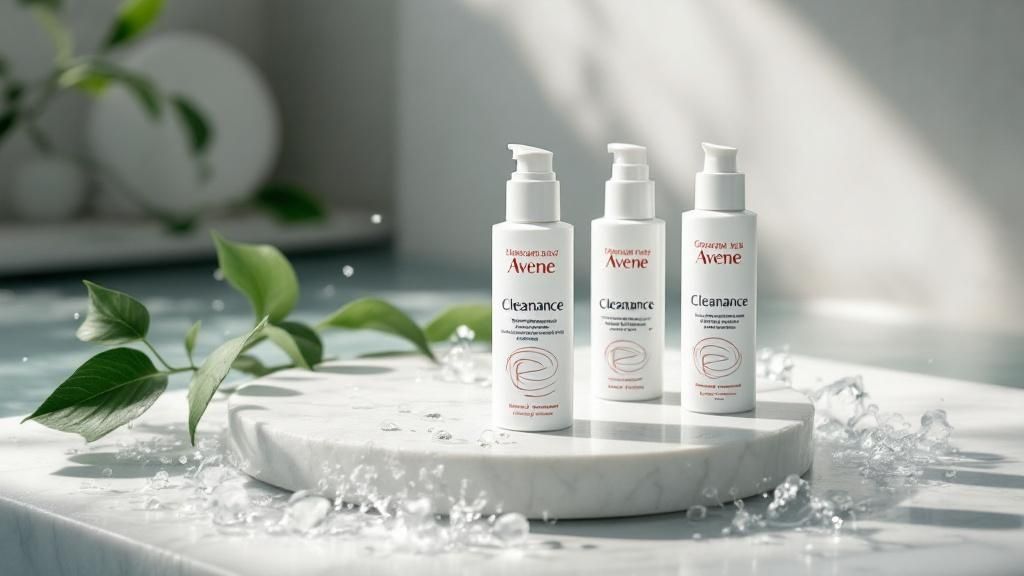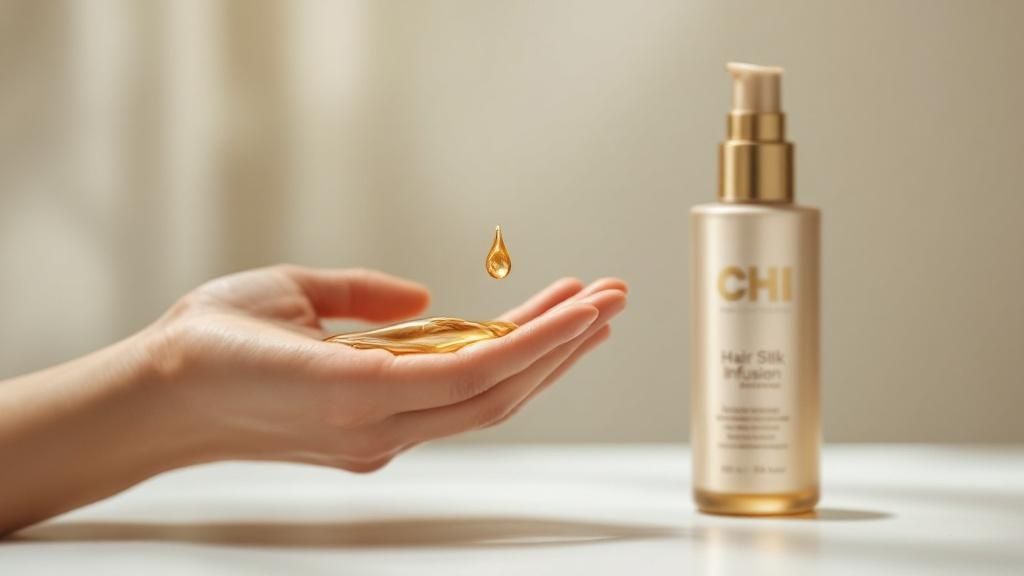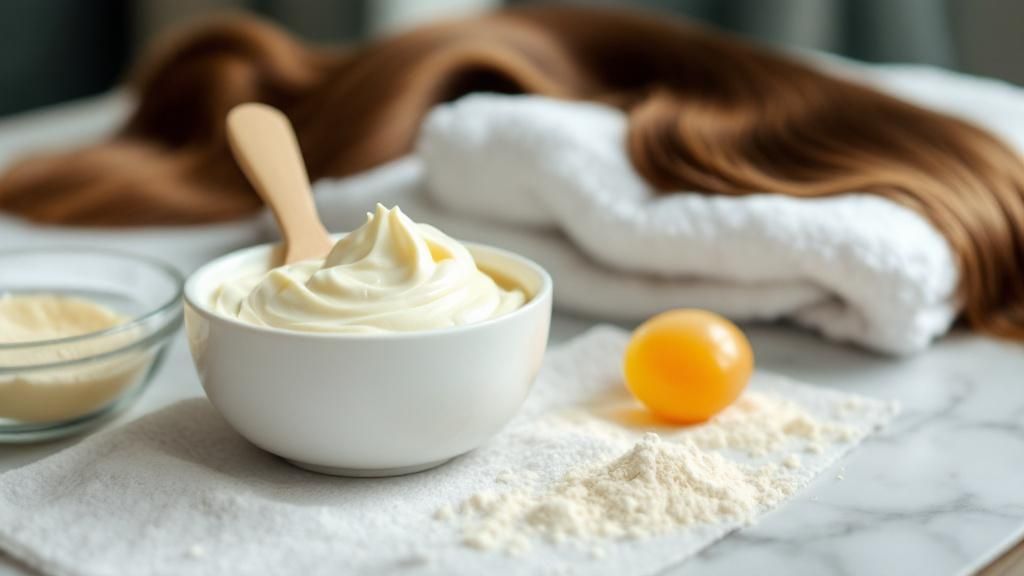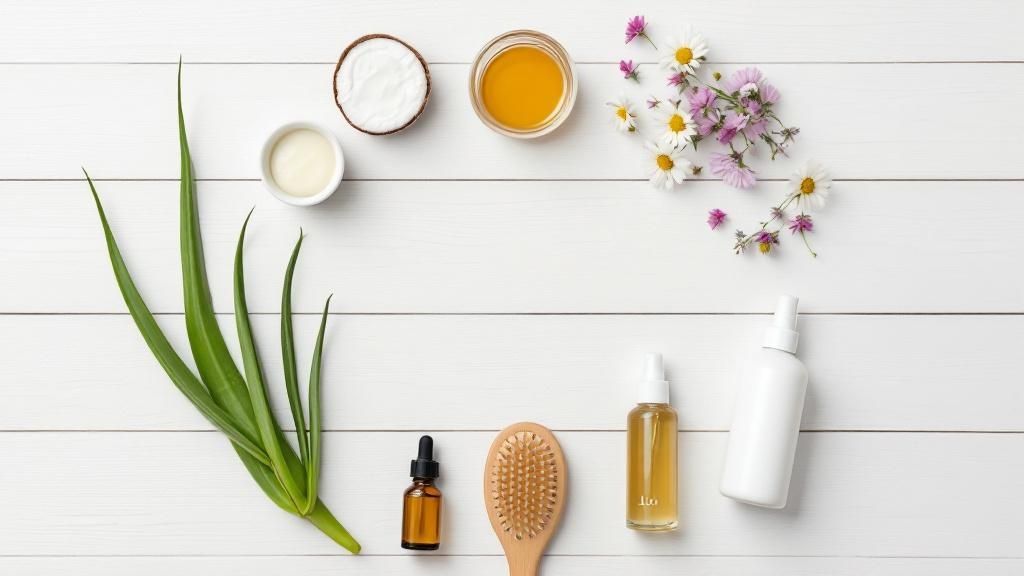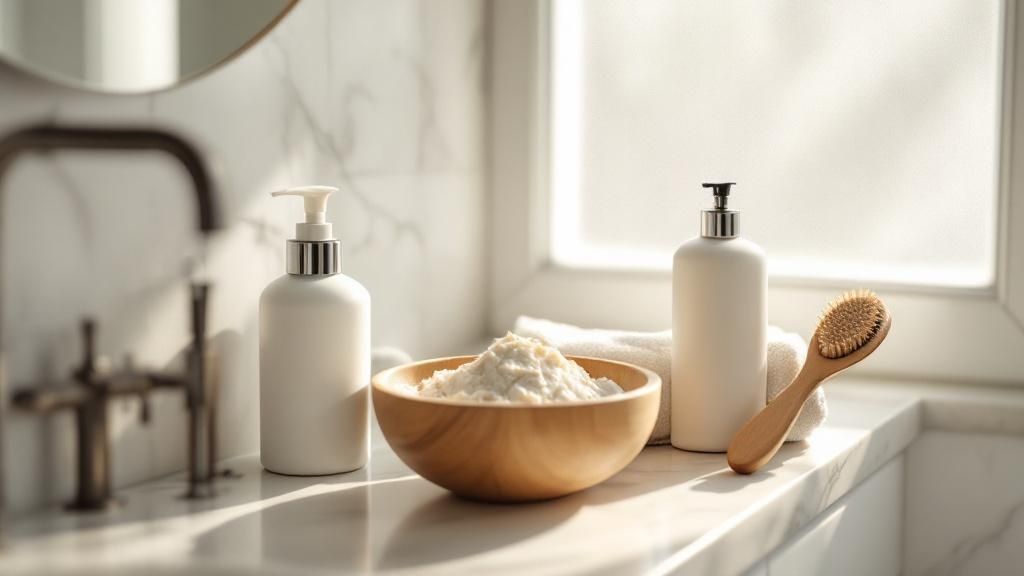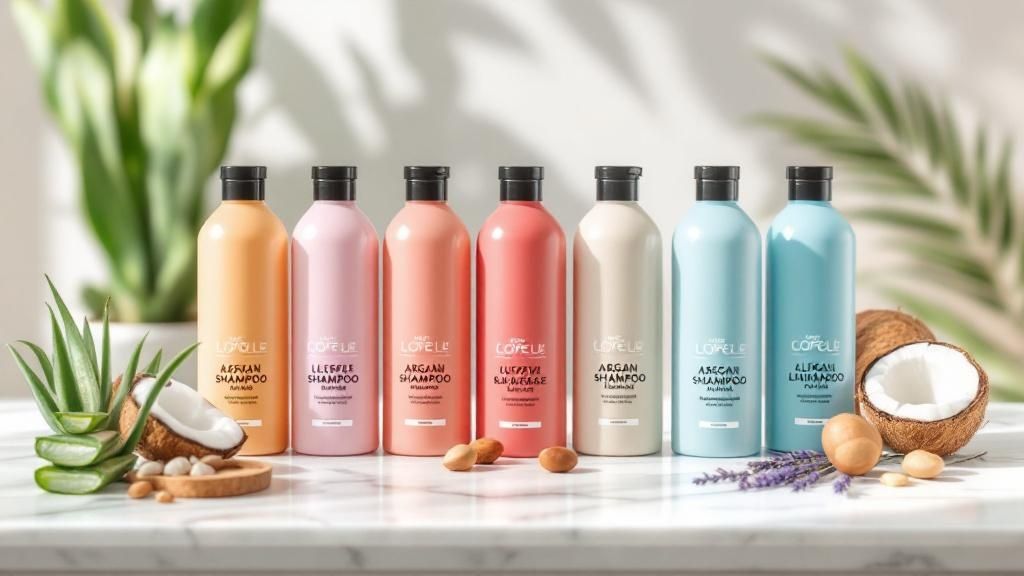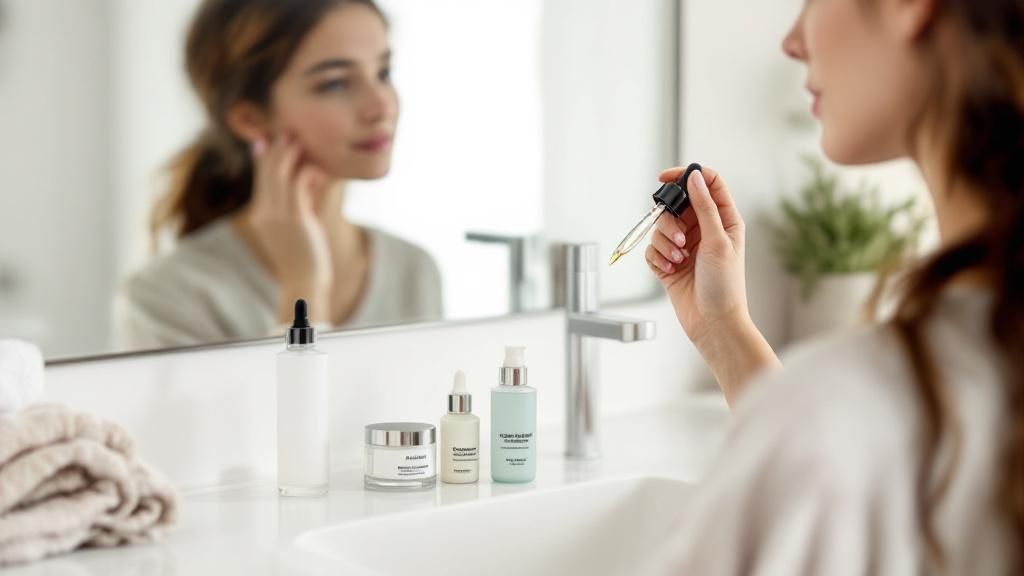
A Realistic Guide to Skincare for Acne Prone Skin
When it comes to tackling acne-prone skin, the most powerful tool you have is a simple, consistent routine. I've learned from years of experience—both my own and helping others—that the secret isn't some complex, 10-step ritual. It’s about sticking to the basics: cleansing away impurities, treating breakouts with the right active ingredients, and keeping your skin hydrated and balanced.
This isn't about attacking your skin; it's about supporting it. Whether you're fighting hormonal flare-ups, stubborn blackheads, or those frustrating whiteheads, a solid framework performed day in and day out is what truly brings your skin back into balance.
Why Does Acne Happen Anyway?
Before we jump into products, it helps to know what we're up against. A pimple doesn’t just show up out of nowhere. It's the end result of a process that a good skincare routine can interrupt at multiple points.
Think of it as a domino effect: it usually starts with too much oil, which then leads to a clogged pore, and finally, that dreaded inflammation and redness.

Each step in the routine we're about to build is designed to stop this progression. That’s why a well-rounded approach is so much more effective than just zapping a spot when it appears.
The 4 Cornerstones of an Effective Acne Routine
A great acne-fighting routine is built on four essential pillars. Each one has a specific job to do, and they all work together to manage breakouts and promote clearer, healthier skin.
-
Cleanse: This is your non-negotiable first step. A good cleanser washes away the daily accumulation of oil, dead skin cells, and bacteria that are just waiting to clog your pores. It’s all about creating a clean slate so your treatment products can actually work. A gentle yet effective option like the CeraVe Blemish Control Cleanser is a fantastic starting point.
-
Treat: This is where you bring in the heavy hitters—active ingredients like salicylic acid or benzoyl peroxide. These are the ingredients that directly target existing acne, unclog pores, and help prevent new blemishes from forming.
-
Moisturise: One of the biggest myths I hear is that oily skin doesn’t need a moisturiser. Nothing could be further from the truth! When your skin gets dehydrated, it often panics and produces even more oil to compensate, which just makes acne worse. A lightweight, non-comedogenic (meaning it won't clog pores) moisturiser is absolutely critical.
-
Protect: Think of sunscreen as your insurance policy. Daily SPF is your single best defence against the dark marks (post-inflammatory hyperpigmentation) that pimples leave behind. The sun makes these marks darker and harder to fade, and it can also weaken your skin's barrier, making you more prone to breakouts.
Here’s a simple way to visualise how these steps fit into your day.
Your Daily Acne Care Blueprint
This table offers a quick overview of the essential steps in a daily skincare routine designed to manage acne and maintain skin health.
| Step | Morning Purpose | Evening Purpose |
|---|---|---|
| Cleanse | Remove oil and sweat from overnight | Wash away makeup, SPF, dirt, and pollutants from the day |
| Treat | Protect against environmental stressors (e.g., antioxidants) | Target active breakouts and promote cell turnover |
| Moisturise | Hydrate and create a smooth base for SPF/makeup | Repair the skin barrier and lock in hydration overnight |
| Protect | Defend against UV damage and post-acne marks | Not applicable (your skin is in repair mode) |
Viewing your routine as a complete system helps you understand why every step matters. Cleansing preps the canvas, treatments do the hard work, moisturising repairs the barrier, and sunscreen protects all your progress. If you skip a step, you weaken the whole system.
This is a particularly pressing concern here in Egypt, where acne is an incredibly common issue for young people. In fact, studies show that 70% to 80% of adolescents and young adults experience some form of acne. This widespread issue has fuelled a significant increase in demand for targeted acne products, with the market growing by roughly 15% each year.
Decoding Ingredients for Acne-Prone Skin
Let's be honest, standing in the skincare aisle can feel overwhelming. With endless products all promising clear skin, how do you choose? The secret isn't in the fancy packaging; it's on the back of the bottle. Learning to read and understand an ingredient list is the single most powerful tool you have in your fight against acne. It’s the difference between guessing and making a truly informed choice.
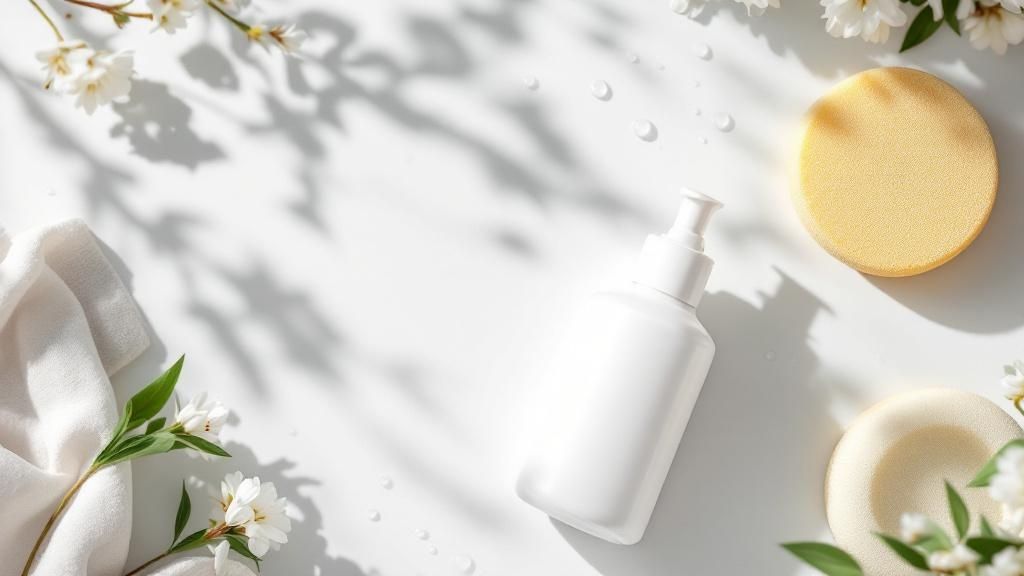
This knowledge is crucial, especially here in Egypt. Data from the Ministry of Health and Population shows that acne vulgaris drives nearly 25% of all visits to dermatology clinics across the country. In response, our local pharmacies are well-stocked with proven solutions. The most common and effective treatments you'll find are built around benzoyl peroxide and salicylic acid, and for good reason. You can explore more on these skincare market trends and their impact.
The Heavy Hitters in Acne Treatment
When you start scanning those ingredient lists, you'll see a few names pop up again and again. These are the tried-and-true actives, each tackling acne from a different angle. Knowing what they do helps you pick the right one for your specific breakouts.
-
Salicylic Acid (BHA): This is my go-to recommendation for blackheads and whiteheads. As an oil-soluble acid, it dives deep into your pores to break down the gunk—the mix of oil and dead skin cells—that causes blockages in the first place.
-
Benzoyl Peroxide: If you're dealing with red, angry, inflamed pimples, this is your powerhouse. It’s incredibly effective because it kills the C. acnes bacteria that fuels those painful breakouts and calms the surrounding inflammation.
-
Niacinamide (Vitamin B3): Think of this as the ultimate supporting actor. Niacinamide is brilliant for regulating oil production, soothing redness, and helping to repair your skin's natural barrier. It's gentle and works well alongside other acne treatments.
My Essential Pro Tip: Never, ever slather a new active ingredient all over your face right away. Always do a patch test first. Just dab a tiny amount on a hidden spot, like behind your ear or on your inner wrist, and wait a full 24 to 48 hours. If there's no redness or irritation, you're good to go.
Looking Beyond the Actives
Beyond the main ingredients, there are a few other clues on the label that can help you out. The most important phrase to look for is “non-comedogenic.” This is industry-speak for "this formula won't clog your pores." It’s not a 100% guarantee, but it’s a very good start.
On the flip side, be wary of potential irritants. Even if an ingredient isn't pore-clogging, things like heavy oils, synthetic fragrances, and certain types of alcohol can aggravate sensitive, acne-prone skin, which can ironically lead to even more breakouts.
To make the choice a little easier, I've put together a quick comparison of the most common active ingredients. This should help you pinpoint which one is best suited for your skin's current needs.
Key Acne-Fighting Ingredients Compared
| Ingredient | Best For | How It Works | Potential Side Effects |
|---|---|---|---|
| Salicylic Acid | Blackheads, whiteheads, clogged pores | Exfoliates inside the pore, dissolving oil and dead skin | Dryness, mild irritation |
| Benzoyl Peroxide | Red, inflammatory pimples and pustules | Kills acne-causing bacteria, reduces inflammation | Dryness, peeling, potential bleaching of fabrics |
| Niacinamide | Oily skin, redness, post-acne marks | Regulates oil, calms inflammation, supports skin barrier | Very rare, generally well-tolerated |
Remember, starting low and slow is always the best approach. If you're new to these ingredients, begin with a lower concentration—think a 2.5% benzoyl peroxide gel or a cleanser with 1-2% salicylic acid. This gives your skin time to adjust without becoming overly dry or irritated, which is the key to getting clear skin that lasts.
Why Moisturiser and SPF Are Your Secret Weapons
There's a persistent myth out there that if you have oily, acne-prone skin, you should dry it out as much as possible and skip things like moisturiser. I’ve seen this mistake derail so many people’s progress. Let’s be clear: skipping moisturiser and sunscreen is one of the biggest missteps you can make when trying to get clear skin.
These two products aren’t just extras; they are the absolute heroes of any effective routine for tackling acne.
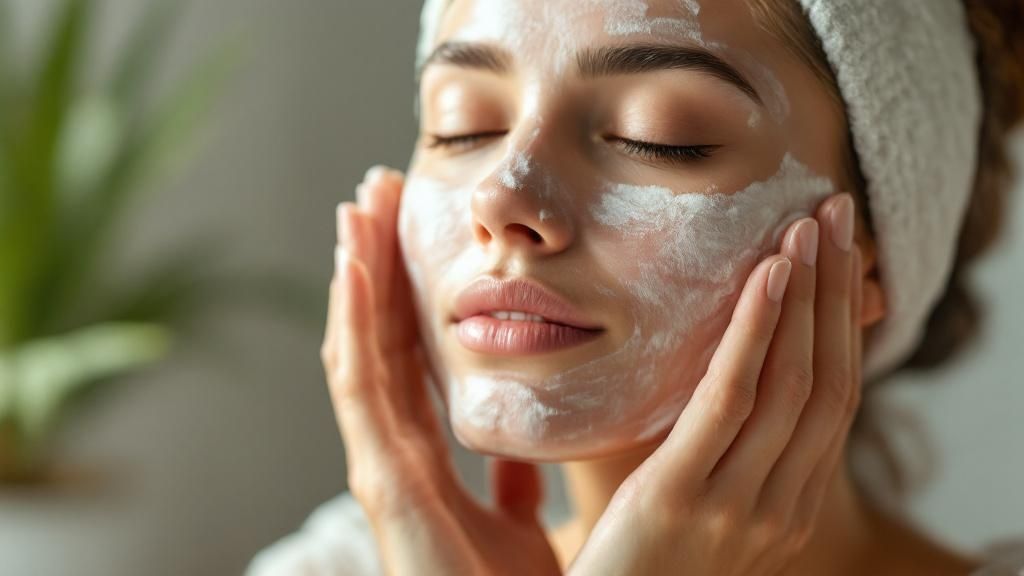
Think about it. Most acne treatments—the good ones, anyway—are designed to go after oil and speed up skin cell turnover. While that’s great for clearing breakouts, it can be pretty harsh on your skin’s natural protective layer, what we call the moisture barrier.
When that barrier gets damaged, it can’t do its job properly. It loses its ability to hold onto water, leading to dehydration, and it becomes an open door for irritants. Your skin might start feeling uncomfortably tight, look red, or become overly sensitive. In a panic, your skin can actually overproduce oil to compensate, leaving you even greasier and, you guessed it, potentially leading to more clogged pores. It's a vicious cycle.
Hydration Is All About Finding Balance
This is exactly why a good moisturiser is non-negotiable. Its primary role is to replenish what your treatments take away, supporting and repairing your skin barrier, locking in hydration, and calming down any irritation.
The trick for acne-prone skin isn't to pile on a thick, heavy cream. You need to be strategic. Look for specific formulas that deliver hydration without creating new problems.
- "Non-Comedogenic" is Key: This should be the first thing you look for on any label. It simply means the product is formulated to be less likely to clog your pores.
- Go for Lightweight Textures: Think gel-creams and light, water-based lotions. These absorb quickly and give you all the hydration you need without that heavy, greasy feeling.
- Hero Ingredients to Spot: Keep an eye out for hyaluronic acid for a surge of lightweight moisture, ceramides to rebuild your skin barrier, and niacinamide to calm redness and help regulate oil production.
A healthy, hydrated barrier is a resilient one. It can handle your active treatments better and is far less prone to inflammation, which is crucial for finally breaking that breakout cycle. Even your cleanser can contribute to barrier health. For instance, using a gentle, hydrating cleanser like the CeraVe Hydrating Cleanser sets the right tone for a routine focused on balance.
Your Best Defence Against Post-Acne Marks
Sunscreen is, without a doubt, your most powerful tool for preventing the ghosts of pimples past. Those dark spots that linger long after a breakout has healed? That’s called post-inflammatory hyperpigmentation (PIH), and UV exposure makes it so much worse. The sun triggers melanin production, which makes those marks darker, deeper, and much more stubborn to fade.
Sunscreen isn't just about preventing sunburn. For anyone with acne, it’s a daily treatment to prevent and fade those frustrating post-acne marks. If you're not using it consistently, the sun is actively working against your efforts to clear your skin.
On top of that, many of the best acne-fighting ingredients, like salicylic acid and retinoids, make your skin significantly more sensitive to the sun. Using these powerful actives without daily SPF is practically asking for sun damage. This not only deepens hyperpigmentation but also weakens your skin’s overall health in the long run.
Your new non-negotiable habit? A broad-spectrum, oil-free sunscreen with at least SPF 30. Apply it every single morning, rain or shine. No excuses.
Leveling Up Your Routine with Advanced Actives
Once you’ve nailed down a consistent, basic routine, you can start exploring more powerful treatments. This is where the real magic happens for tackling those stubborn issues that acne often leaves in its wake, like rough texture and those frustrating dark spots known as post-inflammatory hyperpigmentation (PIH).
It's not about throwing everything at your skin at once. The real skill is learning how to introduce potent ingredients strategically so they work together, not against each other. We want to add heavy-hitters like retinoids, Vitamin C, and chemical exfoliants (think AHAs) without sending our skin barrier into a complete meltdown.
Safely Introducing Retinoids
Retinoids, whether you’re using an over-the-counter retinol or a prescription-strength tretinoin, are true game-changers for both acne and skin texture. They speed up how quickly your skin cells turn over, which is fantastic for keeping pores clear and helping old marks fade away. The catch? They are notoriously strong and can cause a lot of irritation, peeling, and dryness when you first start. This initial adjustment period is sometimes called 'retinisation'.
To get around this, I swear by the 'retinoid sandwich' method. It’s a simple trick that makes a huge difference:
- After cleansing, apply a light layer of your moisturiser to dry skin.
- Wait a few minutes for it to sink in, then apply a pea-sized amount of your retinoid.
- Seal it all in with another thin layer of moisturiser on top.
This technique creates a buffer that lets your skin reap the benefits of the retinoid while dramatically reducing the risk of irritation. Begin by using your retinoid just one or two nights a week, and only increase how often you use it once you know your skin is handling it well.
One of the most critical steps before applying any advanced active is making sure your canvas is perfectly clean. You need to get rid of every last bit of makeup, sunscreen, and daily grime. A great option for this is a product like La Roche-Posay's Effaclar Micellar Water, which preps your skin for powerful ingredients without stripping it bare.
Alternating Actives for Maximum Benefit
You absolutely cannot use every powerful ingredient in the same routine. In fact, trying to do so is a fast track to a damaged, angry skin barrier. The smartest way to use multiple actives is to alternate them on different nights.
Key Combination Rules to Remember:
- Never Mix: Don’t use retinoids in the same routine as AHAs/BHAs (like glycolic or salicylic acid) or Vitamin C. It’s simply too much for the skin and a recipe for irritation.
- Morning vs. Night: Vitamin C is a potent antioxidant, so it performs best in the morning when it can protect your skin from daily environmental stressors. Save retinoids and strong exfoliants for your nighttime routine, as they can make your skin more sensitive to the sun.
Here’s what a practical weekly schedule could look like. Notice the built-in "rest nights."
| Day | Morning | Evening |
|---|---|---|
| Monday | Vitamin C, Moisturiser, SPF | Retinoid (Sandwich Method) |
| Tuesday | Vitamin C, Moisturiser, SPF | Hydration & Barrier Repair Only |
| Wednesday | Vitamin C, Moisturiser, SPF | Chemical Exfoliant (AHA) |
| Thursday | Vitamin C, Moisturiser, SPF | Hydration & Barrier Repair Only |
| Friday | Vitamin C, Moisturiser, SPF | Retinoid (Sandwich Method) |
| Saturday | Vitamin C, Moisturiser, SPF | Hydration & Barrier Repair Only |
| Sunday | Vitamin C, Moisturiser, SPF | Hydration & Barrier Repair Only |
Giving your skin dedicated nights to just hydrate and recover is a non-negotiable part of this process. It allows your skin barrier to repair itself, which ultimately makes your active treatments more effective and keeps your skincare for acne prone skin sustainable for the long haul.
Lifestyle Habits That Actually Impact Your Skin
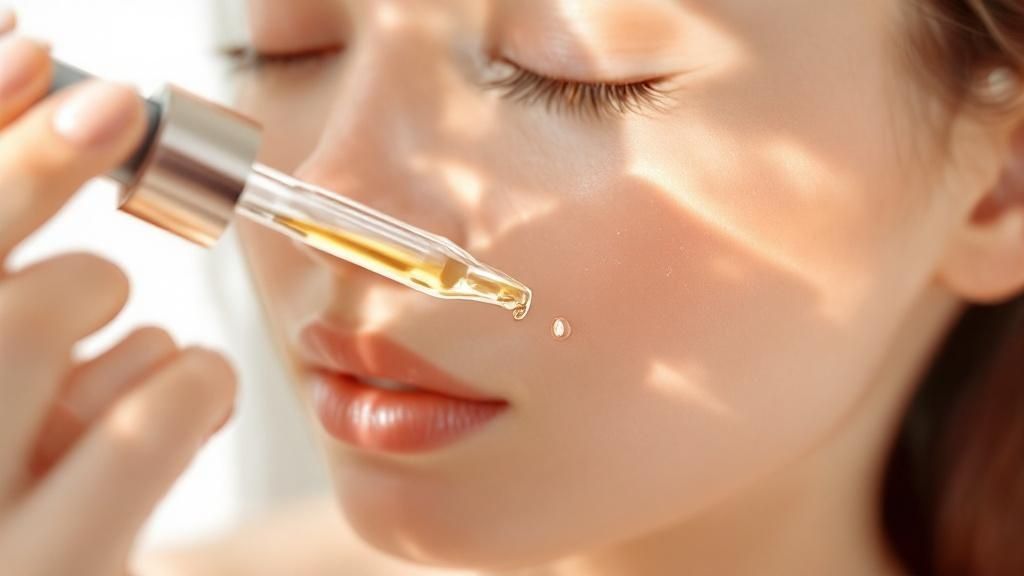 A fantastic skincare routine is only half the battle. What you do between cleansing and moisturising truly makes or breaks your results. To get the best out of your products, you need to think holistically; your daily habits must support the hard work your skincare is doing.
A fantastic skincare routine is only half the battle. What you do between cleansing and moisturising truly makes or breaks your results. To get the best out of your products, you need to think holistically; your daily habits must support the hard work your skincare is doing.
I like to tell my clients to think of their products as their offence and their lifestyle as their defence. Without a solid defence, you're just constantly fighting new flare-ups. So, let's get into the simple, high-impact adjustments that create an environment where clear skin can finally thrive.
The Diet and Acne Connection
The relationship between diet and acne isn't always straightforward, but a growing body of research points a finger at high-glycaemic foods. These are things that spike your blood sugar rapidly—think white bread, sugary snacks, and many processed foods. That sudden spike can kick off a hormonal chain reaction, increasing inflammation and oil production, which is a perfect storm for breakouts.
This doesn't mean you have to sentence yourself to a miserable, restrictive diet. It's really about making smarter, mindful swaps.
- Reach for whole grains instead of white bread.
- Choose a piece of fruit over a sugary dessert.
- Swap sugary sodas for plenty of water.
Making small, consistent choices is far more sustainable and effective than a dramatic, short-lived diet overhaul.
Your goal isn't dietary perfection, but progress. By focusing on whole, low-glycaemic foods most of the time, you reduce one of the key internal triggers for inflammation, giving your topical skincare a better chance to succeed.
Managing Stress and Its Impact
Ever notice a massive spot appearing right before a big exam or an important meeting? It’s not your imagination. When you're stressed, your body pumps out cortisol, a hormone that can throw your oil glands into overdrive.
Finding healthy ways to manage that stress is, in itself, a crucial skincare strategy. This could be anything from a short daily walk to practising mindfulness for a few minutes or just making time for a hobby you love. Whatever works for you, managing stress consistently helps keep cortisol levels stable, which in turn reduces the odds of those frustrating stress-induced flare-ups.
Simple Habits for Clearer Skin
Sometimes, the most powerful habits are the simplest ones. Think about all the surfaces you touch daily—they're covered in bacteria, oil, and product residue that can easily transfer to your face and clog your pores.
Here are two habits that should be non-negotiable:
- Wash your pillowcases weekly. You spend hours every night with your face pressed against that fabric. Keeping it clean is an absolute must.
- Clean your makeup brushes regularly. Brushes are a breeding ground for bacteria. Aim for a thorough wash at least once a week.
Another game-changing habit is to keep your hands off your face. Your hands touch doorknobs, keyboards, and phones all day. Every time you rest your chin in your hand, you're transferring that grime directly onto your skin. It’s such a simple change, but it makes a world of difference.
The growing awareness of factors like these is reflected in the local acne treatment market, which is projected to expand by around 12% annually in Egypt. You can learn more about how the regional skincare market is responding to local triggers like pollution from reports by Fortune Business Insights.
Got Acne Skincare Questions? I've Got Answers
Even when you feel like you've finally got a handle on your acne-prone skin, questions are bound to pop up. It’s totally normal. Getting to clearer skin is a journey with plenty of twists and turns, so let's clear up some of the most common questions I hear.
How Long Does It Really Take to See Results?
This is the hard part: you have to be patient. I know it’s tough, but you’re looking at a full skin cycle—that's about four to six weeks—before you’ll see the first real signs of progress. Active ingredients don't work overnight; they need that time to start doing their job, regulating how your skin cells turn over and clearing out all that underlying gunk.
With stronger stuff like retinoids, you might even be waiting closer to three months to see the full, amazing effect. The absolute biggest mistake you can make is giving up too soon or hopping from one product to the next. Stick with it. Consistency is what lets the ingredients you've chosen actually work their magic.
A little insider tip: sometimes the first sign that a product is working can look like a step backwards. If you get a temporary flare-up in your usual breakout spots in the first 2-4 weeks, that’s often 'purging'. It’s actually a good sign! It means cell turnover is kicking into high gear and pushing all those tiny, hidden clogs to the surface.
Can I Use Face Oils If I Have Oily Skin?
Yes, you absolutely can! But it's all about choosing the right kind of oil. There's this stubborn myth that oil just creates more oil, but the truth is some oils can actually help balance your skin's own sebum production and strengthen your moisture barrier. The trick is to find oils that are non-comedogenic and feel lightweight on the skin.
Here are a few of my go-to, acne-friendly oils:
- Squalane Oil: It's incredibly similar to your skin's natural oils, so it moisturises without that heavy, greasy feeling.
- Jojoba Oil: The structure of this oil is almost a mirror image of your skin's own, which can help signal it to calm down on the oil production.
- Rosehip Oil: A fantastic source of linoleic acid (something acne-prone skin often lacks), and it’s a brilliant helper for fading post-acne marks.
My advice? Always introduce a new oil slowly. Start by mixing just one or two drops into your moisturiser at night to see how your skin gets on with it. You'll definitely want to steer clear of heavy, pore-clogging oils like coconut oil or cocoa butter on your face.
What’s the Difference Between Purging and a Breakout?
Telling the difference between your skin 'purging' and having a full-on breakout can be confusing, but there are some tell-tale signs to look for.
Purging is a direct result of an active ingredient (like a retinoid or BHA) speeding up your skin cell turnover. It forces pre-existing clogs to the surface much faster than they would normally appear. The key things to notice are that these spots pop up in your usual breakout areas and they tend to heal much quicker than a typical pimple.
A breakout from a bad product reaction is a different story. This is when pimples start showing up in new places where you don't normally get them. These blemishes might also look angrier—more red, itchy, or inflamed—which is your skin's way of screaming that it's irritated or having an allergic reaction. If you suspect this is happening, the best thing to do is stop using the new product immediately.
Do I Really Need a Moisturiser If My Skin Is an Oil Slick?
Yes. One hundred percent, yes. This is one of the most important things to get right. Oily skin is a type—it’s down to genetics and hormones. Dehydrated skin is a condition—it’s caused by a lack of water. And it's incredibly common for oily skin to also be dehydrated.
Think of it this way: when your skin is thirsty for water, its defence mechanism is to produce even more oil to try and make up for the moisture loss. This just creates a vicious cycle of more shine and more clogged pores.
By using a lightweight, oil-free, gel-based moisturiser, you give your skin the pure hydration it's crying out for without adding any grease. Taking this simple step helps repair your skin barrier, which, over time, can actually lead to more balanced, less oily skin.
At lo.la, we get that finding the right products is the foundation of a great routine. Explore our hand-picked collection of authentic, effective skincare solutions for every skin concern. Find your next holy grail product today at lolabeautyshop.com.










